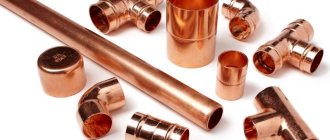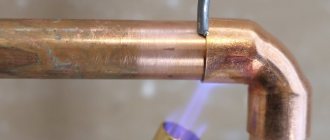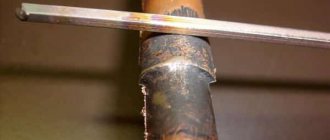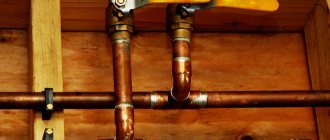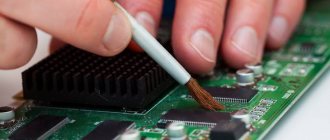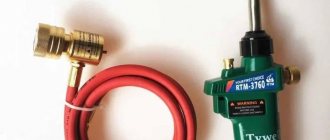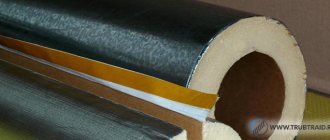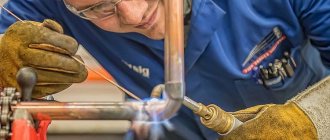Flux is a chemical substance that is used when soldering, in particular, copper pipes and helps to better fill the joint space with solder. Flux also performs another very important function - it cleans the metal product from contaminants and oxidation products. In addition, it forms a protective film that prevents the seam from coming into contact with oxygen.
Soldering copper pipes requires the use of special materials, one of which is flux
Copper pipeline soldering technology
Copper pipes are used for the installation of various communications: water pipes, heating systems and gas pipes. They have a number of advantages, such as:
- are resistant to the harmful effects of corrosion;
- the surface of copper pipes is quite smooth;
- UV resistant;
- have a high thermal conductivity coefficient;
- able to withstand high temperatures;
- have good strength;
- The service life of a copper pipeline reaches 50 years.
Note! The main disadvantage of such a pipeline is its relatively high cost, however, copper material remains popular as it is very reliable and durable.
Soldering is used to connect individual elements of a copper structure. Its varieties are as follows:
- soldering at high temperature;
- soldering at low temperature.
High-temperature soldering is used to obtain a joint with increased strength. Low-temperature soldering is used in all other cases.
Features of soldering with flux
If we compare soldering using flux and arc soldering, in the first case the performance will be higher. The use of flux when soldering copper pipes allows the use of increased current density. The use of high currents, in turn, affects the depth of pipe melting. At the same time, you should not worry that the electrode will lose its coating material due to high temperatures.
The use of flux allows you to obtain a denser and more uniform seam
The use of flux allows you to avoid a large number of foreign inclusions, since pores do not form in the seam during soldering. Before purchasing flux for soldering copper pipelines, it is advisable to pay attention to its distinctive features. For example, to eliminate the possibility of the appearance of an oxide film, the following measures must be taken:
- Monitor the soldering temperature of soft solder for copper pipes and joints until the temperature is the same. When choosing a flux, you should pay attention to its performance. This indicator depends on the type of solder.
- If it is possible to achieve temperature uniformity between the soft joint and the solder, it can be used as a device that measures changes in temperature, which eliminates the possibility of overheating during soldering.
When purchasing a suitable solution for a particular case, you should pay attention to its quality.
Moderately corrosive compounds
Fluxes made from rosin to which alcohol is added with any of the following substances are characterized by low corrosive activity:
- acetic acid,
- zinc chloride,
- orthophosphoric acid.
When soldering, a copper flux made from a solution of rosin in alcohol with the addition of zinc and ammonium chlorides works well. It is effective to use a mixture of glycerin and a solution of zinc, ammonium, and sodium chlorides.
A high-quality connection during soldering is ensured by a flux made from a solution of glycerin in water, to which hydrazine hydrochloride is added. You can successfully use a mixture of alcohol and phosphoric acid solution.
Fluxes containing rosin are used at temperatures up to 300 °C. Other compositions can be heated to 350 °C.
What characteristics should a flux have for soldering copper pipes?
A high-quality flux used for soldering copper pipelines must meet certain requirements. Let's look at them:
- Regardless of the type, the composition must be evenly distributed over the working surface;
- the viscosity and density of this substance should be less than that of solder. This is necessary for substitution to occur;
- the flux must dissolve the oxide film and prevent re-oxidation of the copper part;
- in addition, such a substance should ensure a neat appearance of the seam;
- the composition should not be destroyed as a result of exposure to high temperatures;
- after soldering is completed, dirt and dust should be easily removed;
- The flux must allow soldering in both vertical and horizontal areas.
A high-quality flux in the form of a paste should be viscous and dense, then it will be evenly distributed over the surface of the pipe
A high-quality flux must have all of the above characteristics. After soldering is completed, this substance is removed using special solvents.
Types of fluxes
All fluxes differ from each other in various respects, but most often in the elements included in their composition. In order to clean the metal to be soldered from contaminants, the following types of fluxes are used:
- boric acid;
- zinc chloride;
- hydrochloric acid.
And to create a film that will perform protective functions, you can use:
- rosin;
- wax;
- various resins.
When soldering copper pipes, various types of fluxes can be used:
- liquid;
- powder;
- flux paste.
Liquid compositions are usually stored in closed tubes and used together with solders that have a soft consistency. Powder fluxes are less popular due to the inconvenience associated with their use during soldering. Pastes for soldering copper pipes are more expensive, however, they are sold ready-made and can be used immediately. Soldering paste allows you to simplify the process and get an incredibly strong and reliable adhesion of pipes.
Ready-made pastes are easy to use, but are more expensive than other products
Today there are a huge number of varieties of this substance. However, there are three most popular types that are used for soldering, including copper pipes:
Anti-corrosion compounds. Such substances not only perform the function of cleaning the surface from oxidation, but also remove water from the soldering area, displacing it. Using this composition allows you not to remove residues after soldering. It is quite difficult to make such a solution at home.
Compositions based on salicylic acid. In such fluxes, the main active substance is dissolved in a composition that consists of various chemicals: alcohol, petroleum jelly (technical), gold-containing substances. Such fluxes are produced only in industrial conditions and are quite popular, as they affect the quality of the seam. The seam after soldering a pipe using this flux turns out very smooth.
Helpful information! This composition can be made with your own hands at home. As a basis, you can take acetylsalicylic acid (aspirin) tablets and mix them with technical petroleum jelly and alcohol. However, such a flux will have very little heat resistance and is more suitable for soldering various electrical equipment.
Classic rosin. When assembling pipeline communications, rosin is not used in its pure form. Most often, sodium salt is mixed with it, and the result is a substance that has excellent protective and anti-corrosion characteristics for working with pipelines. Rosin envelops the seam with a protective film, and sodium salts prevent oxidative processes. This composition is cheap and is the most popular today. However, this flux also has a drawback - if it overheats, it can become charred. In addition, the seam when soldering with rosin is not as aesthetically pleasing as in the case of salicylic acid-based flux, but strong and reliable.
Rosin is the most affordable and popular material for soldering
Soldering process with an electric soldering iron
The entire technology of soldering wires with a soldering iron can be divided into several successive stages. All of them are repeated in a certain sequence:
- Training of conductors. When soldering wires, they are freed from insulation. After this, the oxide film is removed from them mechanically. You can use a small piece of fine-grit sandpaper. The metal should shine and be light.
- Tinning. Heat the soldering iron to the melting temperature of the rosin (it begins to actively melt when touched). Take a conductor, bring it to a piece of rosin, heat it with a soldering iron so that the entire stripped part of the wire is immersed in rosin. Then take a drop of solder onto the soldering iron tip and spread it over the treated part of the conductor. The solder spreads quickly, covering the wire with a thin layer. To make it distributed faster and more evenly, the wire is turned slightly. After tinning, copper conductors lose their redness and become silvery. This is how all wires that need to be soldered are processed.
That's all. In the same way, you can solder two or more wires, you can solder a wire to some contact pad (for example, when soldering headphones, you can solder the wire to a plug or to a pad on a headphone), etc.
Read also: What happens if the transformer is designed for voltage
After you have finished soldering the wires with a soldering iron and they have cooled down, the connection must be insulated. You can wrap electrical tape, put it on, and then heat up the heat shrink tube. When it comes to electrical wiring, it is usually recommended to first screw on a few turns of electrical tape, and then put a heat-shrinkable tube on top, which is heated.
Differences in technology when using flux
If active flux is used rather than rosin, the tinning process changes. The cleaned conductor is lubricated with the compound, and then heated with a soldering iron with a small amount of solder. Further everything is as described.
Soldering twists with flux - faster and easier
There are also differences when soldering twists with flux. In this case, you can not tin each wire, but twist it, then treat it with flux and immediately start soldering. The conductors don’t even need to be cleaned—the active compounds corrode the oxide film. But instead, you will have to wipe the soldering areas with alcohol to wash away the remnants of chemically aggressive substances.
Features of soldering stranded wires
The soldering technology described above is suitable for monocores. If the wire is multi-core, there are nuances: before tinning, the wires are untwisted so that everything can be dipped in rosin. When applying solder, you need to make sure that each wire is covered with a thin layer of solder. After cooling, the wires are twisted into one bundle again, then you can solder with a soldering iron as described above - dipping the tip into solder, heating the soldering area and applying tin.
When tinning, multi-core wires must be “fluffed”
Is it possible to solder copper wire to aluminum
Aluminum cannot be combined directly with other chemically active metals. Since copper is a chemically active material, copper and aluminum are not joined or soldered. The point is too different thermal conductivity and different current conductivity. When current passes, aluminum heats up more and expands more. Copper heats up and expands much less. Constant expansion/constriction to varying degrees leads to the fact that even the best contact is broken, a non-conducting film is formed, and everything stops working. That's why copper and aluminum are not soldered.
If there is such a need to connect copper and aluminum conductors, make a bolted connection. Take a bolt with a suitable nut and three washers. At the ends of the connected wires, rings are formed according to the size of the bolt. Take a bolt, put on one washer, then a conductor, another washer - the next conductor, a third washer on top and secure everything with a nut.
Aluminum and copper conductors cannot be soldered
There are several other ways to connect aluminum and copper lines, but soldering is not one of them. You can read about other methods here, but bolted is the simplest and most reliable.
Connecting wires is a necessary operation when carrying out electrical work. Each method of connecting electrical wiring (crimping, twisting, soldering) has its own conditions for use. Soldering copper wires and soldering aluminum wires is the most reliable method of contact connection; in terms of strength, it competes only with welding.
What kind of solder should I use to solder copper pipes?
There is a huge variety of solders for connecting individual elements of a copper pipeline using soldering. All of them are divided into two types according to consistency:
- hard (refractory);
- soft (low-melting).
The most popular for these purposes are low-temperature solders. They allow copper pipes to be joined at low temperatures, which eliminates the possibility of their deformation. But it is worth noting that the seams after such solder have rather low mechanical qualities.
High-temperature solders, unlike low-temperature solders, allow you to make the most durable pipe connections.
Important! It is recommended to use high-temperature solders only by experienced specialists who know all the intricacies of soldering copper products. An inexperienced person can simply burn through a copper pipe.
When low-temperature soldering, which is very popular when installing copper pipelines in domestic conditions, solders that do not contain lead are most often used. Lead-free solders provide mechanically resistant adhesion. Lead-free solders include: alloys of tin with bismuth, antimony, silver, etc. Tin in such solders contains about 95%, the remaining 5% comes from additional elements.
In domestic conditions, soft solder is most often used, which contains a large amount of tin.
For soldering at low temperatures, solder, which is an alloy of tin and lead, can be used; however, such material is not recommended for the installation of plumbing structures. This is because lead is a toxic material and can be harmful to the health of occupants.
To solder copper pipes, a special gas burner is used, which allows you to achieve maximum strength and reliability of the connection.
What is the process of soldering wires?
Soldering differs from welding in that during the work it is not the ends of the metal wires being connected that are melted, but only the solder. Soldering must be done with a soldering iron and flux. An alloy of metals (tin, lead, antimony, silver) that melt at a lower temperature is used as solder. Solder melted with a soldering iron spreads, fills the gap between the metal wires and hardens, forming a strong, unbreakable connection. Soldering is reliable not only from a mechanical point of view, but also from an electrical point of view: the contact resistance of the conductors in the junction box depends on the contact area of the parts being connected - the larger it is, the lower the resistance. This means that the wires heat up less and the connection is better.
Considering that a fire can be a consequence of poor contact, in hard-to-reach places it is more advisable to connect the wires by soldering, thereby eliminating the possibility of their disconnection. It is appropriate to solder conductors in the distribution box even if it is located above a suspended or suspended ceiling.
Gas torch for connecting copper pipes
A propane torch is used to connect individual components of copper communications and allows you to work with parts at temperatures from 550 to 2000˚C. In addition, the design of the burner allows you to adjust the flame, depending on the type of solder (high or low temperature).
This device heats up quite quickly - within 10-30 seconds. A huge advantage of such a burner is its portability. It operates without being connected to the mains, which significantly expands its capabilities.
This apparatus is classified depending on the mixture on which it operates:
- mixtures of gas and air;
- mixtures of gas and oxygen.
A mixture of gas and air is used to start household burners. Their characteristics include light weight and the same dimensions. They are used for soldering small sections of pipes. And the combination of gas and oxygen allows you to work with pipes of any diameter.
Copper pipes are soldered using a gas torch, which is compact in size
Safety rules for soldering copper pipes
Soldering copper pipes involves the use of soldering equipment, which requires the necessary skills. When working with soldering equipment, you should pay attention to the following safety rules:
- when sealing a pipe, it is strictly forbidden to hold a segment shorter than 30 cm in your hands under a stream of flame. This is due to the fact that copper is a very good heat conductor and you can get burned;
- If flux gets on your skin, you must immediately wash it off with water. Otherwise, you may get a chemical burn;
- When carrying out the soldering process with a torch, you need to take care of your clothes - they should only be made of natural fabrics;
- Before soldering a copper pipeline, care must be taken to ensure that the room is properly ventilated. This is necessary because the solder used to solder copper pipes emits harmful substances.
What is needed for soldering
To solder copper conductors, you will need the following devices, materials and tools:
- Electric soldering iron with a power of 80 watts or more
- Solder
- Flux
- Flux remover (neutralizer)
- Pliers
- Flux brush
- PVC electrical tape
- Heat shrink tube of suitable diameter
- Hairdryer
You can solder copper wires not only with an electric soldering iron, but also with other equipment: a propane torch for soldering copper pipes, a mini gas torch, or a gas soldering iron with a torch attachment.
A burner with a small torch is convenient in that it provides local heating of the twist without damaging the conductor insulation. Before using an electric soldering iron, its tip must be cleaned from oxides with a file or sandpaper. It is recommended to use POS-60 or analogues with a melting point of 190°C as a solder for copper.
Flux removes metal oxides, promotes better adhesion of solder and its uniform spreading over the surface. It is better to use water-based flux - it does not contain alcohol or acid, so it does not require subsequent removal. If you use orthophosphoric acid, liquid rosin or LTI-120 for this purpose, then the products must be removed from the surface after work - otherwise they will destroy copper parts over time.
Read also: Solid fuel boiler ash regulator
